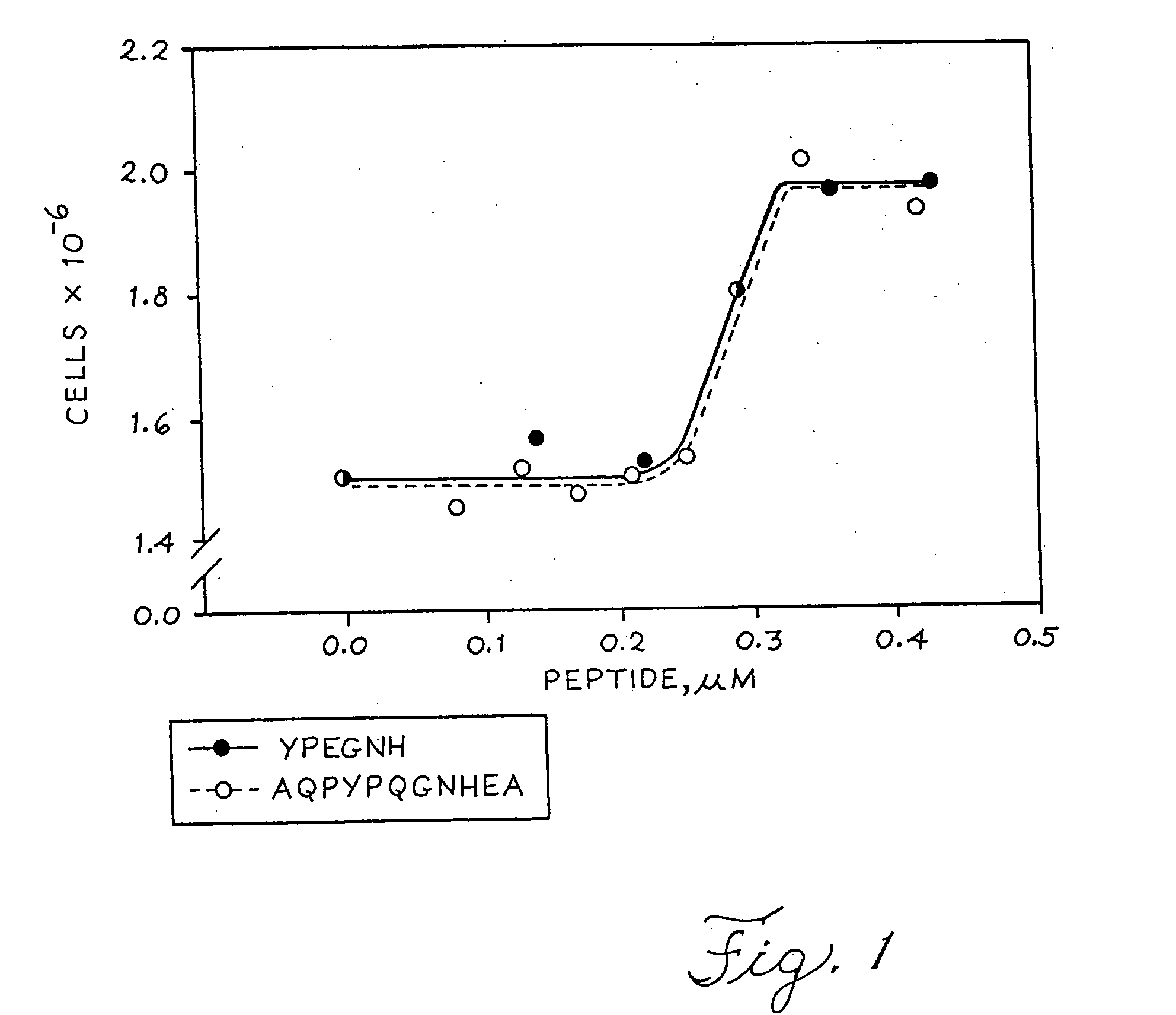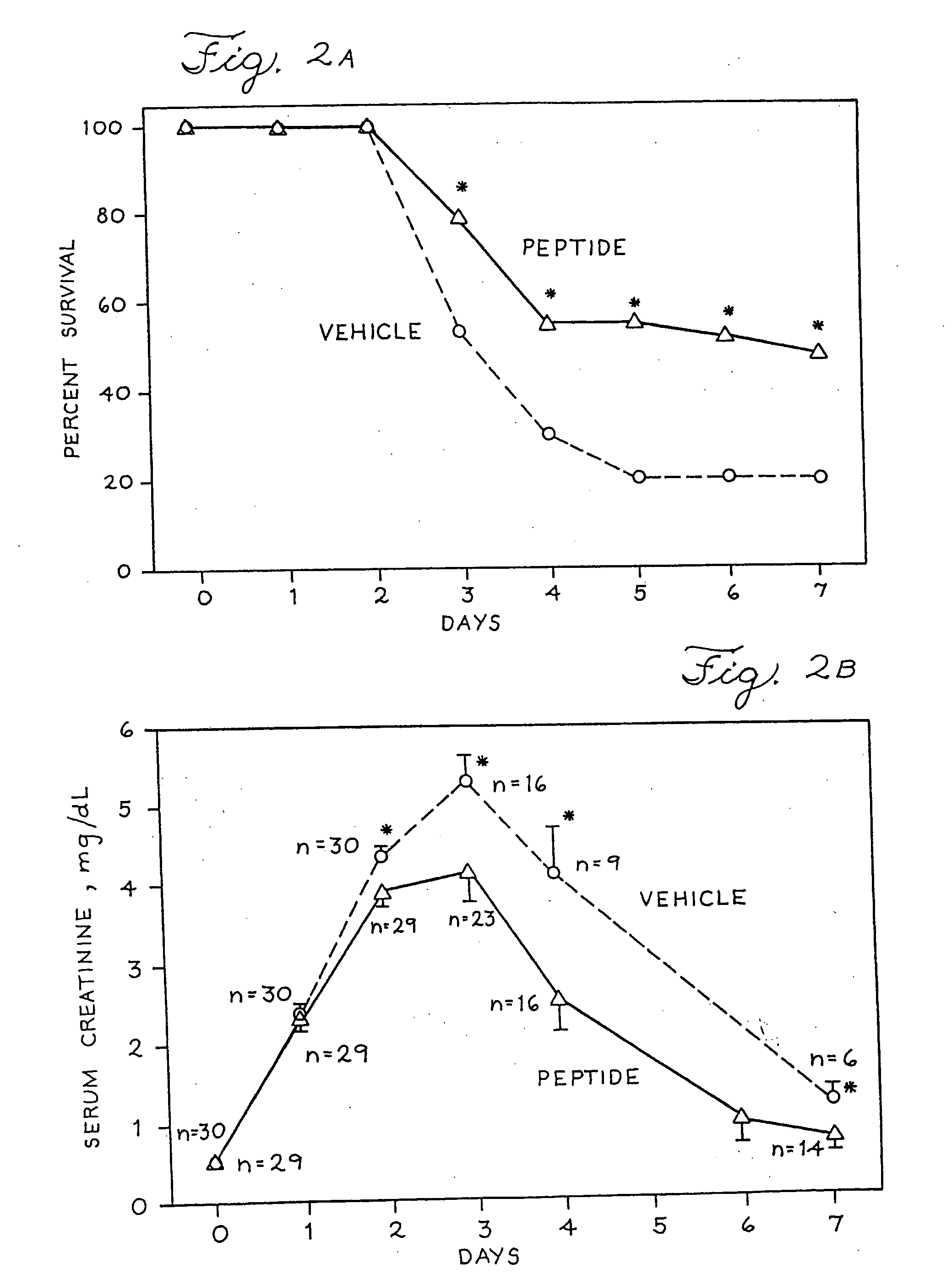Methods for production of growth-promoting proteins and peptides for kidney epithelial cells
a technology of growth-promoting proteins and peptides, which is applied in the direction of peptide/protein ingredients, peptide sources, drug compositions, etc., can solve the problems of high mortality, acute renal failure, and staggering total cost to the u.s. healthcare system of almost $2.5 billion per year, so as to improve survival, improve renal function, and improve renal function. function
- Summary
- Abstract
- Description
- Claims
- Application Information
AI Technical Summary
Benefits of technology
Problems solved by technology
Method used
Image
Examples
example 1
14-Ser Peptide is Effective in the Treatment of Nephrotoxic Acute Renal Failure
[0175] Nephrotoxic and ischemic acute renal failure (ARF) induced experimentally in rats have long been used to model this syndrome in humans. To determine if the mitogenic effect of 14-Ser, a WGF-derived NH2-terminal peptide, would prove efficacious as a therapeutic agent in animals with ARF, acute tubular necrosis was induced by injecting a solution of mercuric chloride (in normal saline) subcutaneously to rats at a dose of 2.25 mg per kilogram body weight. Male rats weighed 200-225 gm at the start of the experiment. This dose was used because preliminary experiments indicated it results in survival of 25-50% of the animals 7 days later. Blood was obtained from the tail vein each day and the concentration of creatinine in the serum was measured and used as an index of renal function. An increase in serum creatinine concentration signals a decline in renal function because the injured kidney is unable t...
example 2
Improved Survival with 11-mer WGF-Derived Peptide Treatment of Experimental Acute Renal Failure
[0184] Experimental ARF was induced in rats by subcutaneous injection of mercuric chloride. The synthetic peptide AQPYPEGNHEA (SEQ ID NO: 41) (dissolved in sterile 0.01% bovine serum albumin and PBS) was injected subcutaneously into rats two hours after mercuric chloride was given to demonstrate its beneficial effect on survival from the ARF syndrome. In one experiment a total of 17 rats were injected with a dose of mercuric chloride shown to induce ARF. The different amounts of the peptide (known to stimulate growth of kidney cells in culture) were injected into the animals to assess capacity to improve the outcome. Three days later, five of five animals given saline alone and three of three rats given 50 micrograms of the peptide were dead. In contrast, two of three rats given 100 micrograms of peptide were alive, as were five of six given 200 micrograms. In summary, none of eight rats ...
example 3
Effect of Specific WGF-Derived Peptides on Kidney Repair
[0185] In addition, administration of specific WGF-derived peptides or the native protein speeds repair of renal structure. Standard assays in renal growth physiology and pathology are used to demonstrate that the growth-promoting (mitogenic) effect of a WGF peptide or the 22 or 45 kDa protein stimulates an increased number of kidney cells to initiate synthesis of DNA in preparation for cell division, as has been shown in tissue culture.
[0186] Initially, sections of kidney tissue from rats with mercuric chloride-induced ARF are prepared and inspected under light microscopy to compare the extent of renal injury and repair in animals that received WGF peptide and those that received a saline vehicle alone. Another measure of the effect of WGF on recovery is an histopathological assessment based on detailed microscopic inspection of kidney tissue. A scoring system that grades the characteristic features of ARF and recovery is us...
PUM
| Property | Measurement | Unit |
|---|---|---|
| Fraction | aaaaa | aaaaa |
| Atomic weight | aaaaa | aaaaa |
| Atomic weight | aaaaa | aaaaa |
Abstract
Description
Claims
Application Information
 Login to View More
Login to View More - R&D
- Intellectual Property
- Life Sciences
- Materials
- Tech Scout
- Unparalleled Data Quality
- Higher Quality Content
- 60% Fewer Hallucinations
Browse by: Latest US Patents, China's latest patents, Technical Efficacy Thesaurus, Application Domain, Technology Topic, Popular Technical Reports.
© 2025 PatSnap. All rights reserved.Legal|Privacy policy|Modern Slavery Act Transparency Statement|Sitemap|About US| Contact US: help@patsnap.com


